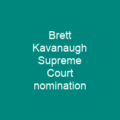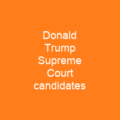The nomination, confirmation, and appointment of Justices to the Supreme Court of the United States involves several steps set forth by the Constitution. The President has the plenary power to nominate, while the Senate possesses the plenaries power to reject or confirm the nominee. Most Presidents nominate individuals who broadly share their ideological views. In many cases, however, a Justice’s decisions may be contrary to what the nominating President anticipated.
About Nomination and confirmation to the Supreme Court of the United States in brief

Most Presidents nominate individuals who broadly share their ideological views. In many cases, however, a Justice’s decisions may be contrary to what the nominating President anticipated. A famous instance was Chief Justice Earl Warren; President Dwight D. Eisenhower expected him to be a conservative judge, but his decisions are arguably among the most liberal in the Court’s history. In 1990, David Souter, who was nominated to the high court in 1990 by President George H. W. Bush, generally fell on the liberal side of the political spectrum. After a first choice is decided, the candidate is contacted and called on by the President to serve. The nominee then meets with senators and prepares for confirmation hearings. The candidate is then told to prepare a statement for an appearance in front of the national press for the President’s formal announcement. After the nominee is confirmed by the Senate, the Senate votes to send the nomination to the President, who can then formally appoint the candidate to the court. The process is relatively recent, with recent nominees only addressing what he or she considers to be slanderous allegations against him or her in 1925, when he was nominated for the post of Justice Stone. In recent years, the process has become more formal, with nominees being interviewed by White House officials before being sent to the White House to be interviewed in person by the president. A formal FBI background check is conducted. The White House staff visits the candidate and goes over tax records and payments to domestic help.
You want to know more about Nomination and confirmation to the Supreme Court of the United States?
This page is based on the article Nomination and confirmation to the Supreme Court of the United States published in Wikipedia (as of Jan. 26, 2021) and was automatically summarized using artificial intelligence.







